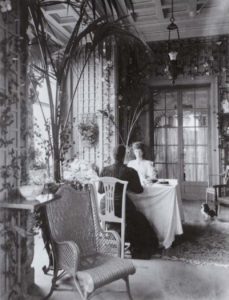Queen Alexandra had often expressed to Bainbridge
a wish to meet Carl Fabergé. In January 1908 an opportunity
arose when he came to London, but as soon as Bainbridge put
forward the Queen’s suggestion Fabergé seemed to be overcome by modesty and – according to Bainbridge – caught a
train back to Paris almost immediately. They were never to
meet. Even in later life Queen Alexandra and her sister Marie
Feodorovna continued to surround themselves with works by
Fabergé at Hvid0re, the villa outside Copenhagen which they
shared.
Queen Alexandra’s passion for Fabergé’s work influenced many in her circle who became his customers, not
least the majority of the crowned heads of Europe. This point
is particularly well illustrated by a recollection of Bainbridge. On one visit which the Queen made to Fabergé’s
premises in Dover Street, she was accompanied by her father
the King of Denmark, the King and Queen of Norway, the
King of Greece, and her own daughter Princess Victoria.12
But her greatest influence was to be over King Edward Vu.
King Edward VII equalled and in some ways surpassed Queen Alexandra in enthusiasm for Fabergé’s work.
He placed the only documented British royal commission with
Carl Fabergé, through H.C. Bainbridge in 1907, when he
ordered a series of models to be made of the favourite horses
and dogs kept at Sandringham, as birthday presents for Queen
Alexandra. This grew into the largest order for animal sculptures ever placed with Fabergé and is the reason why the Royal
Collection today contains the largest surviving group of Fabergé
animal sculptures in existence. Full details of the commission
are set out on pp. 21-4.
Apart from this most significant order, the King purchased many pieces from the London branch and formed a
distinct taste for certain of Fabergé’s products. The London
ledgers provide an insight into his buying habits. In addition to the animals he bought the figure of a Chelsea pensioner
(cat. 234), the sole example in the Royal Collection of the rare
group of hardstone figures of people, of which Fabergé produced only about sixty in total. He purchased several cigarette
cases and may have encouraged his friends to copy him in carrying these elegant accessories. He also received them as gifts.
One example is the coloured gold case made to commemorate his fortieth wedding anniversary (cat. 163), which was
given to him by his sister-in-law, Marie Feodorovna. The most

atHvidore, Denmark c.1908. Photograph by]. Danieleen.
outstanding case he owned, however, was the exquisite blue
enamel piece decorated with a diamond snake which the Hon.
Mrs George Keppel, his favourite mistress, bought for him in
1908 and which to this day contains the stub of one of his
cigars (cat. 187). Although he vied with his consort to be the first to
view new stock from St Petersburg,13
the King’s acquisitions reveal his interest in objects closely associated with his
family life. The frame enamelled in his racing colours and
containing a photograph of his most successful racehorse,
Persimmon (cat. 224), was probably made at his personal suggestion and may have been a prototype for other objects,
for example frames in the racing colours of the King’s friend
Leopold de Rothschild. The series of frames and boxes with
sepia enamelled views of Sandringham, the estate King Edward
VU acquired in 1862 and where he had a new house built, was
also no doubt produced with his involvement – particularly as
he purchased several of them himself (see p. 157). The King
would have been well aware of Fabergé’s work from his visits
to Russia with his family. He was the recipient of two presentation objects from his wife’s nephew Tsar Nicholas u, one
to commemorate his attendance at the Tsar’s coronation in
1896 and the other presented during a diplomatic meeting in
Reval in 1908 (cat. 317 and 326).
For his own purchases, the King sometimes asked
Bainbridge to leave a selection of items at Buckingham Palace
from which he could make a choice.14
Like Queen Alexandra, he was also the recipient of many gifts and he made his
preference for certain of Fabergé’s products very clear. He apparently suggested that, instead of giving him a print, someone who wished to purchase a present for him should ‘go
to Fabergé’s they have a hippopotamus cigar lighter in nephrite
. . . besides the lighter, I am sure, is half the price and it is
amusing